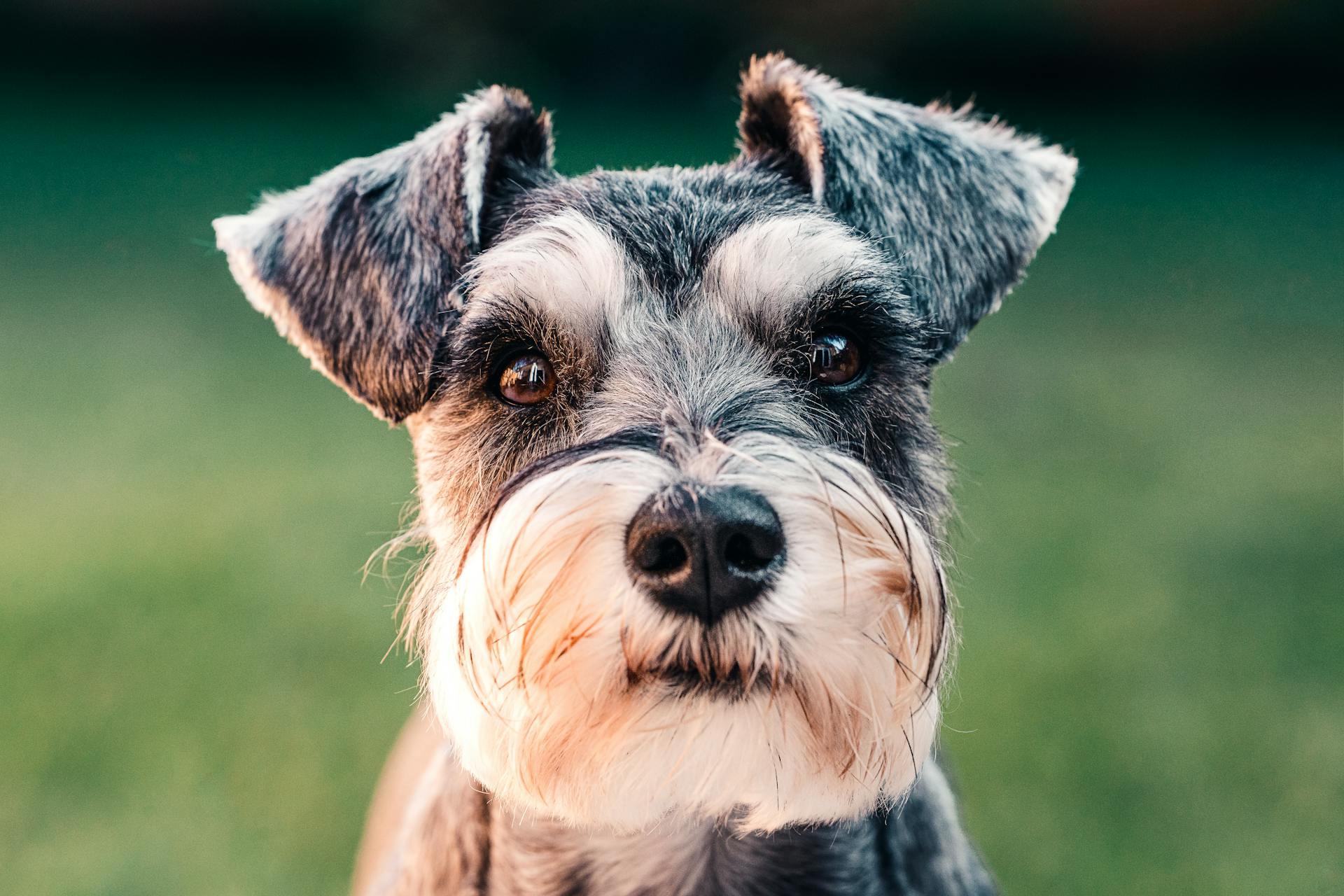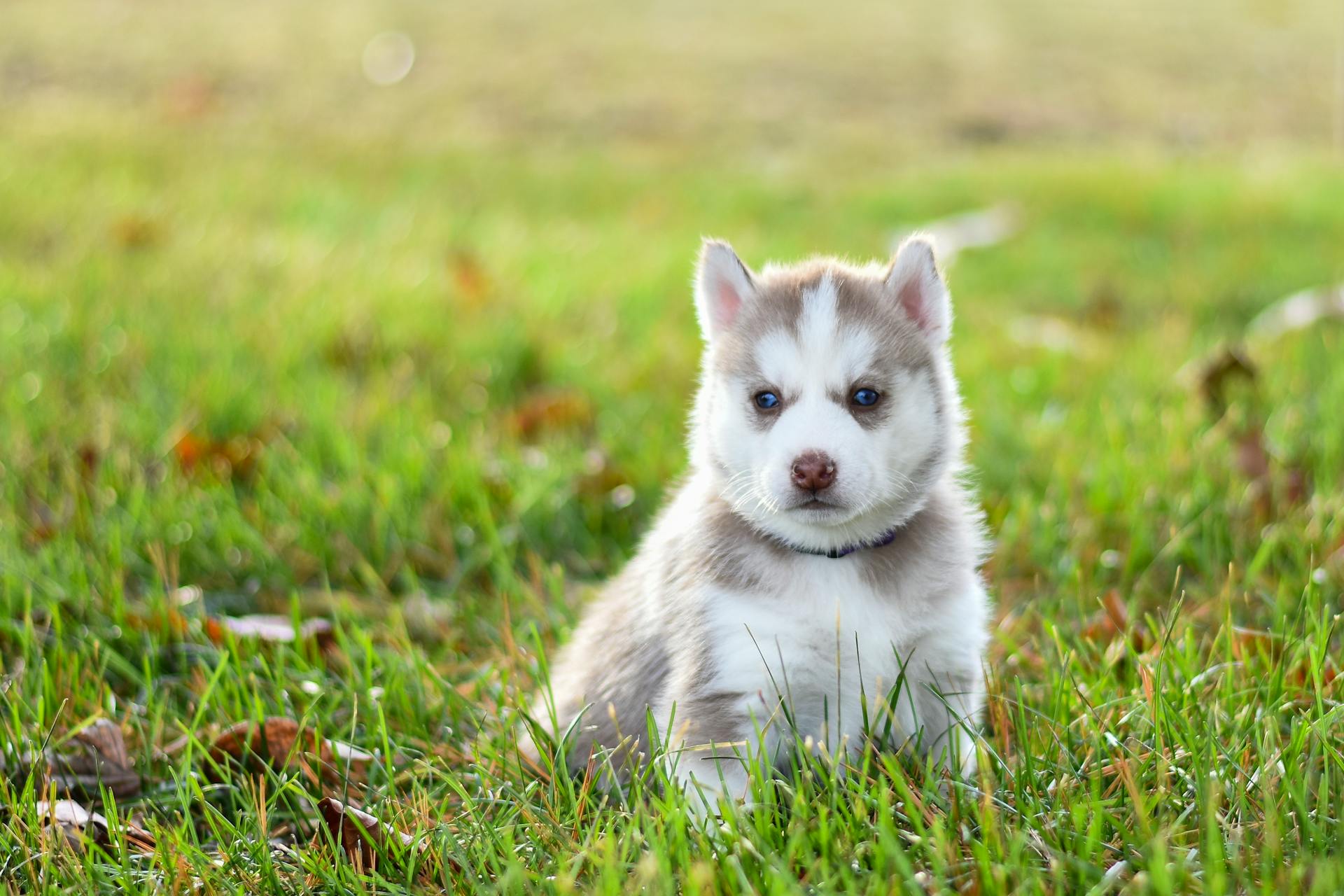
Dogs have been by our side for thousands of years, but when did they become the beloved pets we know today? Archaeological evidence suggests that dogs were first domesticated around 15,000 years ago.
The earliest known evidence of dog domestication comes from a site in Germany, where the remains of dogs were found buried with humans. This discovery suggests that dogs were not just wild animals, but were considered part of the family.
The relationship between humans and dogs has been shaped by thousands of years of selective breeding. Humans chose to breed dogs for desirable traits, such as docility and a smaller size, which led to the development of the first dog breeds.
Broaden your view: First Pitbull Dog
Origin of Dogs as Pets
Dogs were likely first domesticated during the harsh Ice Age winters in Eurasia, when humans had a surplus of lean meat that they couldn't consume themselves. This surplus was a result of the liver's finite ability to metabolize lean meat.
Humans shared this excess lean meat with wolves, who could subsist solely on it for months. This early exchange may have been the key to taming wolves and turning them into our beloved canine companions.
The partitioning theory suggests that competition between humans and wolves was alleviated during the initial phase of dog domestication. This allowed humans to utilize incipient dogs in various ways, such as hunting companions and guards.
Incipient dogs would have undergone many evolutionary changes, similar to those experienced by humans, after being domesticated. This may be one reason why dogs and humans have such a strong bond today.
You might like: Dogs History with Humans
Domestication Theories
The exact origin of domesticated dogs is still debated among scholars, but research suggests it could have happened between 20,000 and 40,000 years ago. This time frame is supported by the fact that the earliest confirmed domestic dog is from a burial site in Germany, dated 14,000 years ago.
One theory is that humans domesticated incipient dogs by providing them with leftover lean meat during the long Ice Age winters. This would have created a mutually beneficial relationship between humans and wolves, leading to the domestication of dogs.
According to some research, the domestication of dogs occurred while humans were all hunter-gatherers, leading to extensively migrant lifeways. As a result, dogs spread with humans, developing in geographic isolation for a time before eventually interbreeding and creating a genetically diverse population.
Key points about the domestication of dogs:
- Wolves and humans were early competitors that both hunted in packs for large prey, shared ecological niches, and could kill each other.
- Debate exists over the exact origin of domesticated dogs, but research suggests that it could have happened between 20,000 and 40,000 years ago.
- Man may have domesticated incipient dogs by providing them with leftover lean meat during the long Ice Age winters.
Two Domestications
The domestication of dogs is a fascinating topic, and it's surprising to learn that there were actually two domestication events that occurred thousands of years ago.
According to research led by bioarchaeologist Greger Larson, there were two places of origin for domestic dogs: one in Eastern Eurasia and the other in Western Eurasia. This is based on mtDNA evidence that suggests Asian dogs originated from a domestication event from Asian wolves at least 12,500 years ago, and European Paleolithic dogs originated from an independent domestication event from European wolves at least 15,000 years ago.
Some of the earliest evidence of dog domestication comes from a burial site in Germany called Bonn-Oberkassel, which has joint human and dog interments dated 14,000 years ago. This is the earliest confirmed domestic dog anywhere.
There's still much to be learned about the domestication of dogs, but one thing is certain: humans and dogs have a special bond that's been developing for thousands of years.
Here's a brief summary of the two domestication events:
It's worth noting that the European Paleolithic dog is now extinct, but its legacy lives on in the many breeds of dogs that we know and love today.
Modern Breed Origination Theories
Dogs are a relatively recent development, with most breeds emerging within the past 500 years.
Breeds vary greatly in size, from the tiny "teacup poodles" that weigh just one pound to massive mastiffs that tip the scales at over 200 pounds.
The domestication of dogs occurred while humans were still hunter-gatherers, leading to dogs spreading with them and developing in geographic isolation for a time.
Curious to learn more? Check out: Dog Breeds Watch Dogs
This isolation eventually gave way to genetic admixture as human populations grew and trade networks expanded, creating a relatively homogenous gene pool for dogs.
Despite selective breeding by kennel clubs, dog breeding was disrupted by World Wars I and II, which decimated or led to the extinction of many breeds.
History of Dog Domestication
Dogs have a rich and fascinating history that spans thousands of years. The earliest confirmed domestic dog was found in a burial site in Germany, dated to 14,000 years ago.
Research suggests that dogs were domesticated from two different wolf populations, one in Eastern Eurasia and the other in Western Eurasia. This is supported by mtDNA evidence that shows ancient Asian dogs originated from a domestication event from Asian wolves at least 12,500 years ago, and European Paleolithic dogs originated from an independent domestication event from European wolves at least 15,000 years ago.
One of the earliest dog domestication events occurred in Asia, where dogs were transported by humans to Europe and displaced the European Paleolithic dogs. However, other scholars have found evidence to support migration events across the central Asia steppe region, but not for a complete replacement.
Readers also liked: One Person Dog
The earliest confirmed domesticated dog in China was found in the early Neolithic Jiahu site in Henan Province, dating back to around 7000-5800 BCE. This was a significant milestone in the history of dog domestication, marking the beginning of a long and enduring relationship between humans and dogs.
Some of the key points about dog domestication include:
- Wolves and humans were early competitors that both hunted in packs for large prey, shared ecological niches, and could kill each other.
- Debate exists over the exact origin of domesticated dogs, but research suggests that it could have happened between 20,000 and 40,000 years ago.
- Man may have domesticated incipient dogs by providing them with leftover lean meat during the long Ice Age winters.
The relationship between humans and dogs is unique and complex, and it's fascinating to explore how it came about. By understanding the history of dog domestication, we can gain a deeper appreciation for the special bond that exists between humans and dogs today.
Modern Dog Ownership
Modern dog ownership has come a long way since ancient times. With the rise of urbanization, dogs are now more likely to be kept as pets rather than working animals.
Dogs are a significant part of many families, with over 69 million households in the United States owning a dog in 2020. This is a 16% increase from 2019.
The shift from working animals to pets has led to changes in how we care for dogs. In ancient Egypt, dogs were often mummified and buried with their owners, showing the strong bond between humans and dogs.
Today, dogs are often considered part of the family, with many owners considering their pets to be a vital member of the household. This is evident in the way many people plan their vacations and daily routines around their dogs.
The rise of dog-friendly spaces and services has also contributed to the modern dog ownership experience. From dog parks to dog daycare, there are now many options available for dog owners to provide their pets with socialization and exercise.
For your interest: Good Guard Dogs for First Time Owners
Sources
- https://www.npr.org/2011/11/08/142100653/how-dogs-evolved-into-our-best-friends
- https://www.ncbi.nlm.nih.gov/pmc/articles/PMC7109016/
- https://www.thoughtco.com/how-and-why-dogs-were-domesticated-170656
- https://www.psychologytoday.com/us/blog/the-red-light-district/202103/when-did-man-first-domesticate-dogs
- https://www.ox.ac.uk/news/2016-06-02-dogs-were-domesticated-not-once-twice%E2%80%A6-different-parts-world
Featured Images: pexels.com


